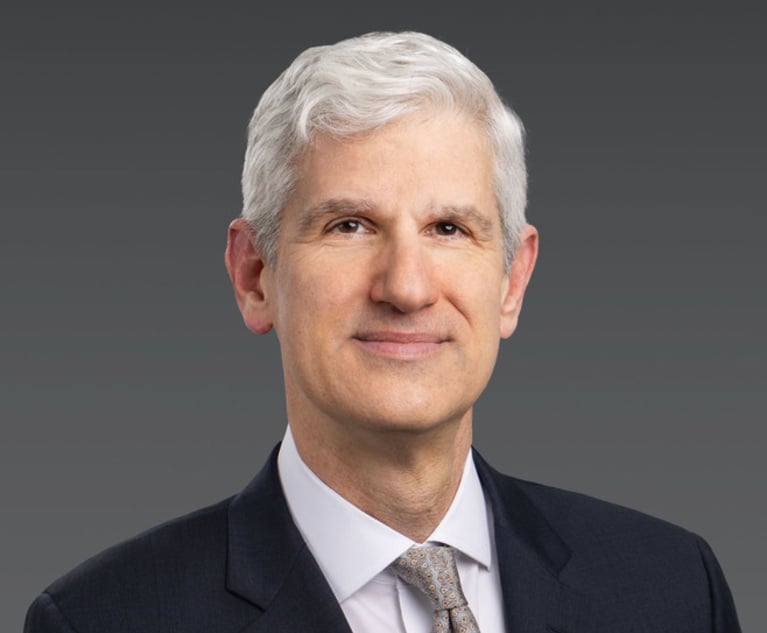What Firms Can Learn From the Great Recession as They Confront the Next Crisis
With the Great Recession in the rearview mirror, history offers some important lessons to the law firms in the Second Hundred as they attempt to navigate through a coronavirus-fueled recession.
May 18, 2020 at 09:35 AM
10 minute read
 Credit: nednapa/Shutterstock.com
Credit: nednapa/Shutterstock.com
As the legal industry reeled from the Great Recession, it was the Am Law 100 that bore the brunt of the 2008 financial crisis, but the Second Hundred's financial indices also declined. More than a decade later, law firms have recovered from the Great Recession, and the Second Hundred have overcome a few years of economic instability to reach new heights.
 What data are you using to stand out in a crowded market? Get the interactive Am Law 200 Data exclusively with Legal Compass.
What data are you using to stand out in a crowded market? Get the interactive Am Law 200 Data exclusively with Legal Compass.
In 2008, the cutoff to make the Second Hundred was $99 million in gross revenue, roughly in line with the cutoff in 2019—$101 million. At the top of the list, though, firm No. 101 (Baker, Donelson, Bearman, Caldwell & Berkowitz) brought home $378.9 million in 2019, nearly 38% higher than 101st-ranked Bracewell & Giuliani's $275.5 million in 2008. As a group, the Second Hundred have grown revenue 19% since 2008, despite the often-challenging economic climate.
But as the Second Hundred's financial health has trended upward since the last recession, the gains have not always been equal. Since 2008, some firms have outperformed their former peers, moving up into the Am Law 100. Others have cemented their place as reliable Second Hundred stalwarts. And along the way, law firm mergers, dissolutions and declines have dropped some to the bottom of the current rankings, or led them to disappear entirely.
The stories of the firms that occupied the Second Hundred in 2008 show that there are many paths to financial success, as well as to failure. And they hold lessons for this year's Second Hundred, which are facing a new economic crisis that could have even more disparate effects.
Consistency Is Key
On the whole, the Second Hundred have improved financially since 2008. The average gross revenue and revenue per lawyer for the group have both increased 19% in that time. Average profits per partner is up 34%, while most firms in the group have maintained a smaller head count—multiple firms at the top of the Second Hundred have fewer than 100 lawyers.
A handful of firms have kept pace with the overall group's healthy growth since 2008, maintaining a consistent presence in the rankings through both the good years and the bad, with measured growth in key practice areas, increased development opportunities for lawyers and more investment on the business side.
Patterson Belknap Webb & Tyler, which had its best-ever financial year in 2019, is one such firm. The single-office New York shop, which was ranked 160th in 2008 with a gross revenue of $147.5 million, has held steady in the middle of the Second Hundred, and ranked 144th in 2019 with a gross revenue of $215.1 million.
While many larger firms were insulated by their size and able to chug along during the Great Recession, Patterson Belknap's managing partner, Lisa Cleary, actually credits the firm's smaller head count and single office as the keys to its success during troubling economic times. It was quickly able to course correct to meet changing demand, she says.
"As a single-office firm of 200 lawyers, we are nimble in response to market changes," she says. Cleary adds that in July 2007, the firm was able to rapidly launch a subprime mortgage practice team to deal with the fallout from the housing crisis. As the economy improved, the group evolved into a structured finance litigation practice group.
The firm also remained strong because it maintained a busy litigation practice with a diverse array of clients across industries, Cleary says.
"We commit to our clients for the long term, and during challenging times we have done our best to remain responsive, and to continue providing clients with the highest level of service," she says.
Cleary attributes the firm's consistent financial performance in recent years to keeping a busy and diverse trial schedule; investing in professional development opportunities for lawyers and staff; and being innovative on the financial side to draw clients in with different pricing strategies and alternative fee arrangements. As the industry faces challenges due to the coronavirus pandemic, she says the firm will respond in similar fashion to the way it responded during the last crisis.
"In 2008, we worked very hard to maintain our head count and did not defer or lay off any attorneys, so that we could be ready to efficiently and effectively serve our clients in litigation emanating from the crisis," Cleary says. "This remains our goal during this pandemic."
Indeed, many successful Second Hundred firms that withstood the stress of the 2008 financial crisis did so because they used their size to their benefit. As Marcie Borgal Shunk, president and founder of law firm consultancy The Tilt Institute, explains, being nimble is an important safeguard against financial crises.
"Firms who are able to quickly identify where and how to deploy scarcer resources and to continue to invest in the keys to growth will outpace the others," she says. "After 2009, those who did not invest quickly enough faltered or failed. Those who did not change fell behind."
Borgal Shunk adds that firms well-positioned in certain industries and markets, such as bankruptcy, telehealth and insurance, will have more flexibility to approach this crisis strategically.
 What data are you leveraging to sell strategy internally? Get the interactive Am Law 200 Data exclusively with Legal Compass.
What data are you leveraging to sell strategy internally? Get the interactive Am Law 200 Data exclusively with Legal Compass.
Other Second Hundred firms, including Stoel Rives (No. 132), Foley Hoag (138) and Ice Miller (150), have duplicated Patterson Belknap's consistent success, each taking steps forward to cement themselves in the middle of the Second Hundred.
Opportunity in Crisis
After the Great Recession, some law firms saw opportunities for growth and expansion, taking advantage as the rest of the legal industry was working to stabilize. In the ensuing years, some midsize and regional firms found a foothold in the Second Hundred, while others gathered enough momentum to move up into the Am Law 100. These firms' success provides a blueprint for how law firms can turn a turbulent economy into a springboard.
Los Angeles-based Buchalter has grown its head count every year since 2012, and debuted on the Am Law 200 at No. 174 after earning $157 million in gross revenue in 2017. It was up to $184.5 million in 2019, and ranked 159th. Adam Bass, the firm's president, chief operating officer and chief executive officer, attributes the firm's success in recent years to expanding its reach nationally and becoming a full-service firm with diverse practice areas that can weather any part of the economic cycle, two growth strategies the firm began in the years following the 2008 crisis.
"We're maintaining our regional footprint while growing our national reach and sticking with the model of wanting to be a full-service firm that offers quality legal services to our clients while maintaining competitive pricing," he says.
While it may seem counterintuitive when the economy is contracting, a strategic growth plan was enough to help multiple firms break into the Am Law 100 in the years following 2008.
"Responding to client demand for greater value with alternative fee arrangements and shifting strategic focus—either broader like Buchalter or, perhaps more common and effective, narrower, like Fisher & Phillips or Knobbe Martens—are definitely two great examples of successful strategies post-2008," says Shunk.
Intellectual property-focused Knobbe has gained 29 spots in the rankings and grown revenue 61% since 2008. Labor and employment-focused Fisher & Phillips, ranked No. 139 this year, has grown revenue 120% since it joined the list at No. 191 a decade ago.
Bass adds that in the current crisis, Buchalter is still expanding by diversifying its practice-group and industry offerings.
"In this unusual time, we've tried to have a diverse business model that leads to noncorrelated practice groups," he says. "We have significant IP, insolvency, financial restructuring, real estate and health care practices. None of these groups are tied to one another, and if one group was down, the other groups could carry the day."
Saul Ewing Arnstein & Lehr; Marshall Dennehey Warner Coleman & Goggin; Butler Snow; Goldberg Segalla; Sherman & Howard; and Arnall Golden Gregory are among a sizable list of firms that carefully navigated the post-recession years to land comfortably in the Second Hundred.
As these firms were growing into fixtures on the Am Law 200, others were finding themselves grouped alongside a new class of competitors as they moved into the Am Law 100. These firms, including Nelson Mullins Riley & Scarborough; Cozen O'Connor, Mintz, Levin, Cohn, Ferris, Glovsky and Popeo; and Davis Wright Tremaine, all resisted large dips in gross revenue from 2008 to 2013, when the U.S. economy was still recovering from the Great Recession, and embarked on different growth strategies.
Nelson Mullins, which ranked 139th in 2008, debuted on the Am Law 100 at 88th in 2017. At the time, the firm attributed its growth to delivering high value to clients at lower prices than its competitors. Three years later, the firm has continued its growth, and after its 2018 merger with Florida's Broad & Cassel, it raked in nearly $558 million in gross revenue to rank 68th on this year's list.
These firms' trajectories show there's no magic formula to earning a spot among Big Law's biggest performers, but rather many strategic paths a law firm can take to outpace the rest of the industry.
Growth Isn't a Given
Many law firms navigated the financial crisis and emerged in better positions, but others weren't so successful. For some, strategic pricing, a slew of lateral hires or a merger weren't enough to stay afloat, driving home the need for firms to take prudent steps to expand their depth or breadth in order to survive a crisis.
Take WolfBlock and Sedgwick, two firms ranked comfortably among the Second Hundred at the time of the last recession that are now among the legal industry's biggest failures. Although WolfBlock earned $160 million in gross revenue in 2008 to rank 153rd, it closed the same year, with many speculating the firm did not diversify its offerings—as Buchalter, Patterson Belknap and others did—and instead focused too much on real estate, an industry that was decimated by the financial crisis.
Sedgwick, which took in $197.5 million in 2008 to rank 132nd, maintained a spot in the Second Hundred until it declared bankruptcy in October 2018. The firm suffered due to aggressive expansion and stagnant profits per lawyer, as its costs per lawyer kept pace with revenue per lawyer, an American Lawyer report last year found. Instead of investing in attorney development, the firm's culture also faltered, as fighting among practice groups and lateral departures led the firm's head count to shrink by 100 attorneys from 2008 to 2015, nearly a quarter of its former size.
For the firms that occupied the Second Hundred the last time a recession hit, some strategies in the face of adversity bore fruit, while others foundered. Now, as this year's Second Hundred stare down another major financial crisis, one that will likely be worse than the last, they can learn from the lessons of the past: focus on strong leadership; stay nimble; capitalize on their smaller size; stick with growth strategies; and diversify services when appropriate. Faced with a daunting future, it could mean the difference between success and failure.
Email: [email protected]
This content has been archived. It is available through our partners, LexisNexis® and Bloomberg Law.
To view this content, please continue to their sites.
Not a Lexis Subscriber?
Subscribe Now
Not a Bloomberg Law Subscriber?
Subscribe Now
NOT FOR REPRINT
© 2025 ALM Global, LLC, All Rights Reserved. Request academic re-use from www.copyright.com. All other uses, submit a request to [email protected]. For more information visit Asset & Logo Licensing.
You Might Like
View All
Paul Hastings, Recruiting From Davis Polk, Adds Capital Markets Attorney
3 minute read
Kirkland Is Entering a New Market. Will Its Rates Get a Warm Welcome?
5 minute read

Goodwin Procter Relocates to Renewable-Powered Office in San Francisco’s Financial District
Law Firms Mentioned
- Mintz, Levin, Cohn, Ferris, Glovsky and Popeo, P.C.
- Sherman & Howard
- Fisher Phillips
- Butler Snow
- Nelson Mullins Riley & Scarborough
- Saul Ewing Arnstein & Lehr
- Arnstein Lehr
- Broad Cassel
- Stoel Rives
- Foley Hoag
- Marshall Dennehey Warner Coleman & Goggin, P.C.
- Goldberg Segalla
- Knobbe Martens Olson
- Arnall Golden Gregory
- Ice Miller
- Patterson Belknap Webb & Tyler LLP
- Baker, Donelson, Bearman, Caldwell & Berkowitz, PC
- Cozen O'Connor
- Bracewell
- Davis Wright Tremaine
Trending Stories
- 1US DOJ Threatens to Prosecute Local Officials Who Don't Aid Immigration Enforcement
- 2Kirkland Is Entering a New Market. Will Its Rates Get a Warm Welcome?
- 3African Law Firm Investigated Over ‘AI-Generated’ Case References
- 4Gen AI and Associate Legal Writing: Davis Wright Tremaine's New Training Model
- 5Departing Attorneys Sue Their Former Law Firm
Who Got The Work
J. Brugh Lower of Gibbons has entered an appearance for industrial equipment supplier Devco Corporation in a pending trademark infringement lawsuit. The suit, accusing the defendant of selling knock-off Graco products, was filed Dec. 18 in New Jersey District Court by Rivkin Radler on behalf of Graco Inc. and Graco Minnesota. The case, assigned to U.S. District Judge Zahid N. Quraishi, is 3:24-cv-11294, Graco Inc. et al v. Devco Corporation.
Who Got The Work
Rebecca Maller-Stein and Kent A. Yalowitz of Arnold & Porter Kaye Scholer have entered their appearances for Hanaco Venture Capital and its executives, Lior Prosor and David Frankel, in a pending securities lawsuit. The action, filed on Dec. 24 in New York Southern District Court by Zell, Aron & Co. on behalf of Goldeneye Advisors, accuses the defendants of negligently and fraudulently managing the plaintiff's $1 million investment. The case, assigned to U.S. District Judge Vernon S. Broderick, is 1:24-cv-09918, Goldeneye Advisors, LLC v. Hanaco Venture Capital, Ltd. et al.
Who Got The Work
Attorneys from A&O Shearman has stepped in as defense counsel for Toronto-Dominion Bank and other defendants in a pending securities class action. The suit, filed Dec. 11 in New York Southern District Court by Bleichmar Fonti & Auld, accuses the defendants of concealing the bank's 'pervasive' deficiencies in regards to its compliance with the Bank Secrecy Act and the quality of its anti-money laundering controls. The case, assigned to U.S. District Judge Arun Subramanian, is 1:24-cv-09445, Gonzalez v. The Toronto-Dominion Bank et al.
Who Got The Work
Crown Castle International, a Pennsylvania company providing shared communications infrastructure, has turned to Luke D. Wolf of Gordon Rees Scully Mansukhani to fend off a pending breach-of-contract lawsuit. The court action, filed Nov. 25 in Michigan Eastern District Court by Hooper Hathaway PC on behalf of The Town Residences LLC, accuses Crown Castle of failing to transfer approximately $30,000 in utility payments from T-Mobile in breach of a roof-top lease and assignment agreement. The case, assigned to U.S. District Judge Susan K. Declercq, is 2:24-cv-13131, The Town Residences LLC v. T-Mobile US, Inc. et al.
Who Got The Work
Wilfred P. Coronato and Daniel M. Schwartz of McCarter & English have stepped in as defense counsel to Electrolux Home Products Inc. in a pending product liability lawsuit. The court action, filed Nov. 26 in New York Eastern District Court by Poulos Lopiccolo PC and Nagel Rice LLP on behalf of David Stern, alleges that the defendant's refrigerators’ drawers and shelving repeatedly break and fall apart within months after purchase. The case, assigned to U.S. District Judge Joan M. Azrack, is 2:24-cv-08204, Stern v. Electrolux Home Products, Inc.
Featured Firms
Law Offices of Gary Martin Hays & Associates, P.C.
(470) 294-1674
Law Offices of Mark E. Salomone
(857) 444-6468
Smith & Hassler
(713) 739-1250









